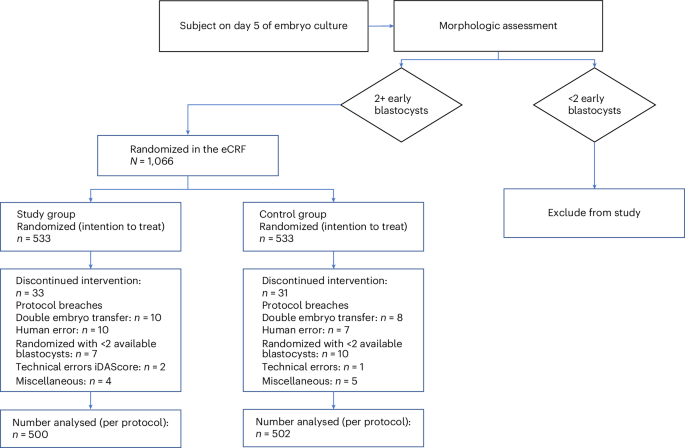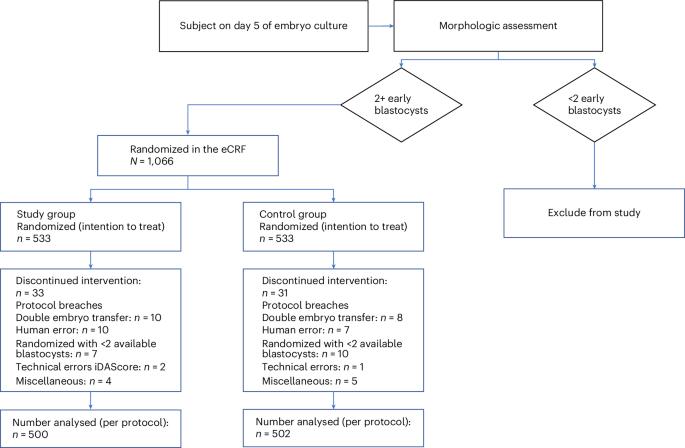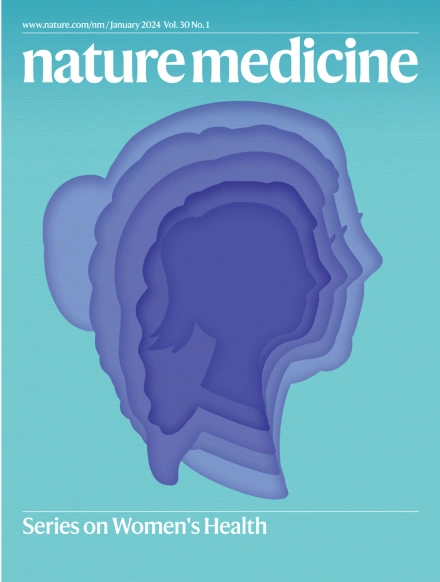Deep learning versus manual morphology-based embryo selection in IVF: a randomized, double-blind noninferiority trial
IF 58.7
1区 医学
Q1 BIOCHEMISTRY & MOLECULAR BIOLOGY
引用次数: 0
Abstract
To assess the value of deep learning in selecting the optimal embryo for in vitro fertilization, a multicenter, randomized, double-blind, noninferiority parallel-group trial was conducted across 14 in vitro fertilization clinics in Australia and Europe. Women under 42 years of age with at least two early-stage blastocysts on day 5 were randomized to either the control arm, using standard morphological assessment, or the study arm, employing a deep learning algorithm, intelligent Data Analysis Score (iDAScore), for embryo selection. The primary endpoint was a clinical pregnancy rate with a noninferiority margin of 5%. The trial included 1,066 patients (533 in the iDAScore group and 533 in the morphology group). The iDAScore group exhibited a clinical pregnancy rate of 46.5% (248 of 533 patients), compared to 48.2% (257 of 533 patients) in the morphology arm (risk difference −1.7%; 95% confidence interval −7.7, 4.3; P = 0.62). This study was not able to demonstrate noninferiority of deep learning for clinical pregnancy rate when compared to standard morphology and a predefined prioritization scheme. Australian New Zealand Clinical Trials Registry (ANZCTR) registration: 379161 . A randomized controlled trial evaluating the selection of a single blastocyst for transfer by deep learning did not demonstrate noninferiority in clinical pregnancy rates when compared to trained embryologists using standard morphology criteria.


试管婴儿中深度学习与人工形态学胚胎选择:随机双盲非劣效性试验
为了评估深度学习在选择体外受精最佳胚胎方面的价值,澳大利亚和欧洲的 14 家体外受精诊所开展了一项多中心、随机、双盲、非劣效平行组试验。第 5 天至少有两个早期囊胚的 42 岁以下女性被随机分配到对照组(采用标准形态学评估)或研究组(采用深度学习算法智能数据分析评分(iDAScore)进行胚胎选择)。主要终点是临床妊娠率,非劣效度为 5%。该试验包括 1066 名患者(iDAScore 组 533 人,形态学组 533 人)。iDAScore组的临床妊娠率为46.5%(533名患者中的248名),而形态学组为48.2%(533名患者中的257名)(风险差异-1.7%;95%置信区间-7.7,4.3;P = 0.62)。与标准形态学和预定义的优先排序方案相比,该研究无法证明深度学习在临床妊娠率方面的非劣效性。澳大利亚-新西兰临床试验注册中心(ANZCTR)注册:379161.
本文章由计算机程序翻译,如有差异,请以英文原文为准。
求助全文
约1分钟内获得全文
求助全文
来源期刊

Nature Medicine
医学-生化与分子生物学
CiteScore
100.90
自引率
0.70%
发文量
525
审稿时长
1 months
期刊介绍:
Nature Medicine is a monthly journal publishing original peer-reviewed research in all areas of medicine. The publication focuses on originality, timeliness, interdisciplinary interest, and the impact on improving human health. In addition to research articles, Nature Medicine also publishes commissioned content such as News, Reviews, and Perspectives. This content aims to provide context for the latest advances in translational and clinical research, reaching a wide audience of M.D. and Ph.D. readers. All editorial decisions for the journal are made by a team of full-time professional editors.
Nature Medicine consider all types of clinical research, including:
-Case-reports and small case series
-Clinical trials, whether phase 1, 2, 3 or 4
-Observational studies
-Meta-analyses
-Biomarker studies
-Public and global health studies
Nature Medicine is also committed to facilitating communication between translational and clinical researchers. As such, we consider “hybrid” studies with preclinical and translational findings reported alongside data from clinical studies.
 求助内容:
求助内容: 应助结果提醒方式:
应助结果提醒方式:


